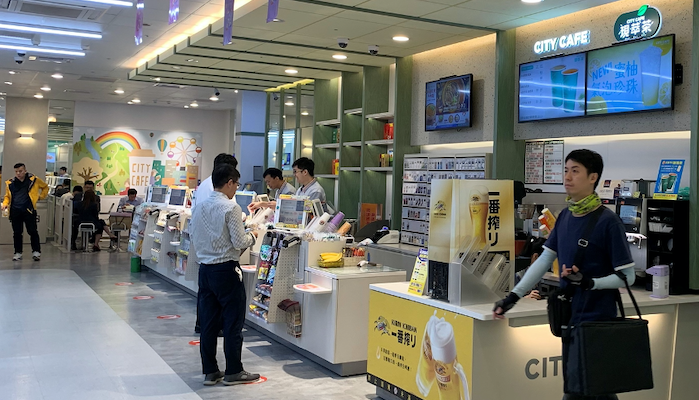In previous articles we discussed the emergence and power of In-Store Digital Media as a new advertising channel. However, digital screens became a common fixture in retail stores long before that.
There is a well-known survey conducted by FedEx Office in 2012 showing that “almost eight in 10 (76 percent) American consumers enter a store they have never visited before based on its signs, and nearly seven in 10 (68 percent) have actually purchased a product or service because a sign caught their eye”. That survey was about the traditional printed signs.
When retailers started experimenting with the replacement of their static signage with connected digital displays, they found them astonishingly effective. For example, when in 2013 Australia’s largest travel retailer, Flight Centre, decided to modernise its stores with more engaging, informative and entertaining Digital Signage solution, they conducted a study and measured their legacy print signage against the new digital installation using Anonymous Video Analytics. The results demonstrated an 89% increase in views and a 52% increase in attention time for the digital screens.
It is no wonder than that Digital Signage is now used so broadly in Retail, as yet another way to attract customers and influence their buying behaviour. To achieve that and to maximise the marketing potential of in-store digital screens, retailers need data. In-store signage is a valuable marketing channel, which is fully owned and controlled by the brand or retailer, and as any communication channel it requires continuous and careful analysis of its performance.
This starts from the layout planning and design, where data can help to define the best location for digital screens, based on the footfall, traffic flows and engagement. That is how, for example, retail banks, like B in the UK (now a part of Virgin Money), are using sensors, data and careful planning to build next-generation banking experiences for their customers.
Once installed, digital screens start attracting customer attention even outside of the store. A common tactic is to have an “attract” display in the shop window or at the entrance. The best way to measure the actual impact of such displays is using Conversion and Engagement metrics. Conversion measurement comes in many shapes, but some of the most interesting KPIs in this case would be the number of watchers and visitors to the number of passers-by. Those KPIs can be measured with Anonymous Video Analytics and Wi-Fi sensors, and in some cases, with mobile location data. Engagement metrics, such as Attention Time can help to further analyse the impact of the shop window display and its content on the customer reaction and store traffic.

Vodafone store shopfront, Australia
Inside the store, digital screens may serve different purposes. Across the floor, they help with brand building by displaying positive and standing-out digital content. In some areas, like queues or waiting rooms, they help to entertain customers. Elsewhere, they are used to inform customers about product features. However, the most common and most powerful use case is promotional content. This is where Digital Signage has the biggest impact, and this is the main reason why retailers install digital screens in their stores. Right content at the right time served to the right audience in a shopping mode provides an immediate effect, which, in the store environment is easy to measure and optimise.
Having full access to their sales and traffic history allows retailers to easily correlate that data with quantitative and qualitative audience measurement statistics for their digital screens.
By carefully crafting and quickly iterating through different variants of a promotional message, while measuring its performance at every turn, brands and retailers are able to increase sales and improve the power of their brand messages over time. These optimisation capabilities are only possible via robust content analytics platforms and cannot exist without data.

Shopper looking at a digital screen at a Harrods department store, UK
The most important metrics helping to assess the performance and impact of the promotional digital content are all about customer engagement, audience segmentation, sales conversion and attribution. Changes in Dwell and Attention Time, Mood, traffic flows split by target demographic groups and correlated with sales data in specific product categories provide rich insights into customer behaviour patterns and trends caused by the brand’s in-store promotional activity.
Continuous analysis of the audience data also enables better understanding of specifics, strengths and weaknesses of every screen and location inside the store. Different areas and screen formats may work best with certain types of content. For example, in 2020, one of the largest duty-free retailers in the world, Dufry, in cooperation with Telefonica On The Spot, conducted a study to analyse how their existing in-store screen formats work with their content. As a result, they found opportunities to optimise the way they were using those screens, by opting for longer brand-building content on the large screen behind the tills while using video content targeted at impulse buying on a smaller screen in the middle of the store. That allowed to maximise the impact of their next campaign by increasing the advertised product’s market share by 320% and quadrupling the purchases of the male customers, while increasing the attention time of the target demographic group by 2.1 seconds on top of the average attention time. This kind of insights is highly valuable to brands and retailers alike and help them plan and execute impactful campaigns while delivering more value to their end customers.
These days camera-based analytics, smart sensors and AI-powered platforms allow targeting audiences and reacting to changes in the context (e.g. weather, traffic, occupancy or new promotions) in real time. This gives brands and retailers another powerful way to communicate with customers, engage them and drive their buying behaviour.
For example, Delhaize Serbia, the largest retail chain in the country, in partnership with Fifth Screen and NDS, is operating an Anonymous Video Analytics system to produce real-time data about the audience in front of their digital screens, to show contextually-relevant promotions to shoppers in order to increase in-store traffic and sales.
By playing messages that resonate best with target categories of shoppers at any given time, while measuring their response to those messages, retailers are able to increase the average basket size and optimise their content strategy to deliver the best ROI.
In the next article we are going to analyse in more detail opportunities presented by real-time data in DOOH and Retail Digital Signage and its applications in interactive campaigns and customer experiences.

